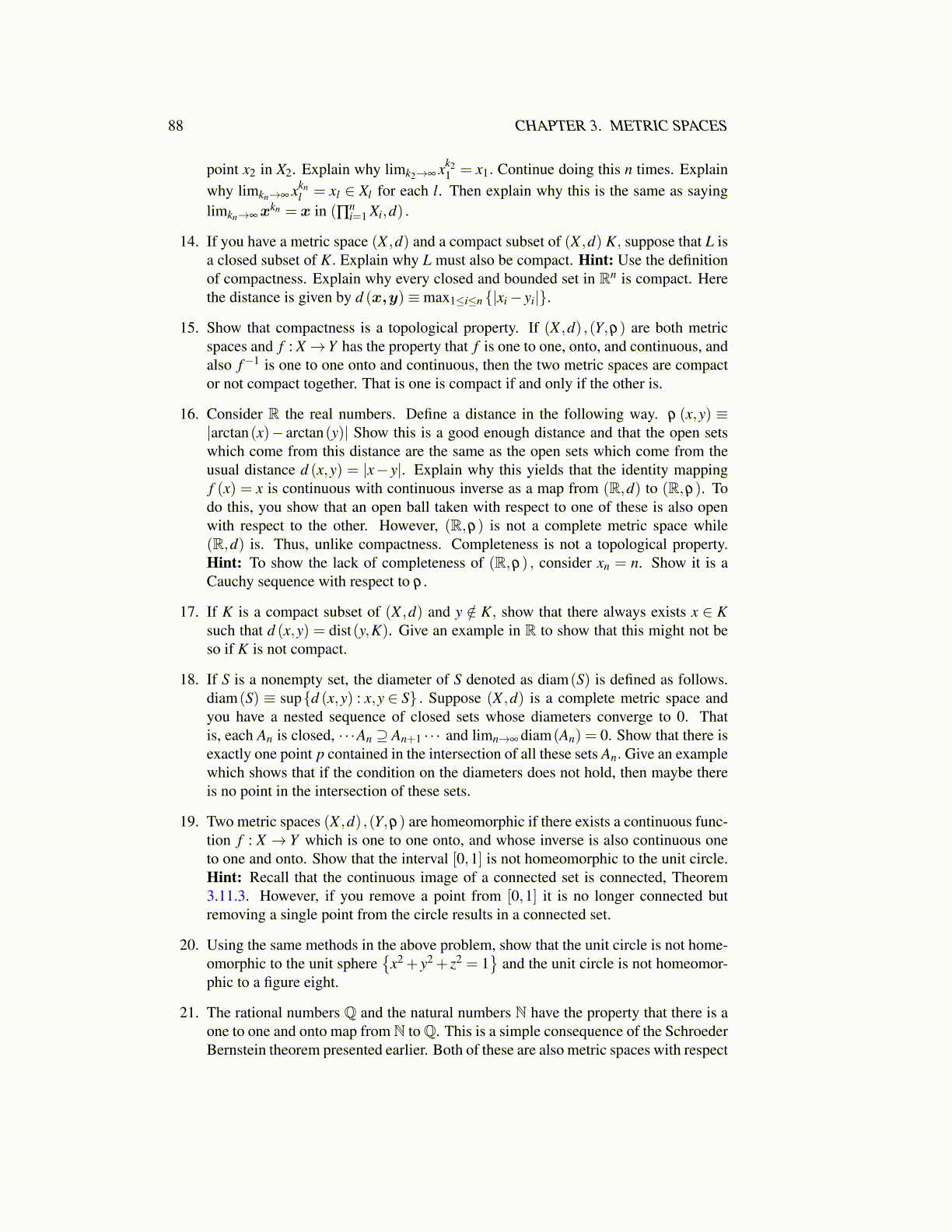
88 CHAPTER 3. METRIC SPACES
point x2 in X2. Explain why limk2→∞ xk21 = x1. Continue doing this n times. Explain
why limkn→∞ xknl = xl ∈ Xl for each l. Then explain why this is the same as saying
limkn→∞xkn = x in (∏ni=1 Xi,d) .
14. If you have a metric space (X ,d) and a compact subset of (X ,d) K, suppose that L isa closed subset of K. Explain why L must also be compact. Hint: Use the definitionof compactness. Explain why every closed and bounded set in Rn is compact. Herethe distance is given by d (x,y)≡max1≤i≤n {|xi− yi|}.
15. Show that compactness is a topological property. If (X ,d) ,(Y,ρ) are both metricspaces and f : X→Y has the property that f is one to one, onto, and continuous, andalso f−1 is one to one onto and continuous, then the two metric spaces are compactor not compact together. That is one is compact if and only if the other is.
16. Consider R the real numbers. Define a distance in the following way. ρ (x,y) ≡|arctan(x)− arctan(y)| Show this is a good enough distance and that the open setswhich come from this distance are the same as the open sets which come from theusual distance d (x,y) = |x− y|. Explain why this yields that the identity mappingf (x) = x is continuous with continuous inverse as a map from (R,d) to (R,ρ). Todo this, you show that an open ball taken with respect to one of these is also openwith respect to the other. However, (R,ρ) is not a complete metric space while(R,d) is. Thus, unlike compactness. Completeness is not a topological property.Hint: To show the lack of completeness of (R,ρ) , consider xn = n. Show it is aCauchy sequence with respect to ρ .
17. If K is a compact subset of (X ,d) and y /∈ K, show that there always exists x ∈ Ksuch that d (x,y) = dist(y,K). Give an example in R to show that this might not beso if K is not compact.
18. If S is a nonempty set, the diameter of S denoted as diam(S) is defined as follows.diam(S) ≡ sup{d (x,y) : x,y ∈ S} . Suppose (X ,d) is a complete metric space andyou have a nested sequence of closed sets whose diameters converge to 0. Thatis, each An is closed, · · ·An ⊇ An+1 · · · and limn→∞ diam(An) = 0. Show that there isexactly one point p contained in the intersection of all these sets An. Give an examplewhich shows that if the condition on the diameters does not hold, then maybe thereis no point in the intersection of these sets.
19. Two metric spaces (X ,d) ,(Y,ρ) are homeomorphic if there exists a continuous func-tion f : X → Y which is one to one onto, and whose inverse is also continuous oneto one and onto. Show that the interval [0,1] is not homeomorphic to the unit circle.Hint: Recall that the continuous image of a connected set is connected, Theorem3.11.3. However, if you remove a point from [0,1] it is no longer connected butremoving a single point from the circle results in a connected set.
20. Using the same methods in the above problem, show that the unit circle is not home-omorphic to the unit sphere
{x2 + y2 + z2 = 1
}and the unit circle is not homeomor-
phic to a figure eight.
21. The rational numbers Q and the natural numbers N have the property that there is aone to one and onto map from N toQ. This is a simple consequence of the SchroederBernstein theorem presented earlier. Both of these are also metric spaces with respect